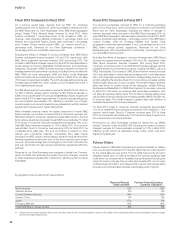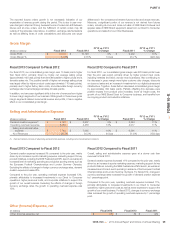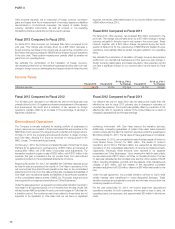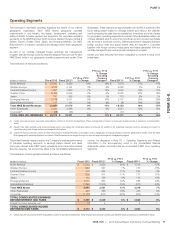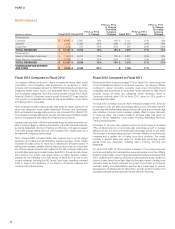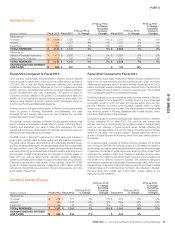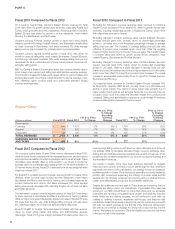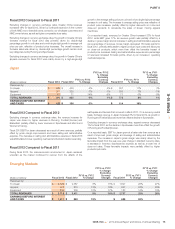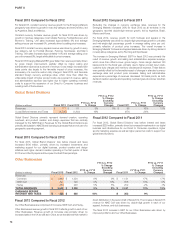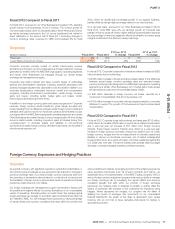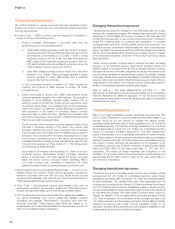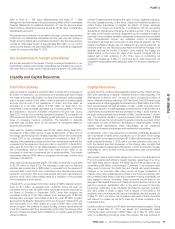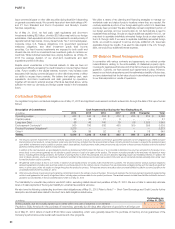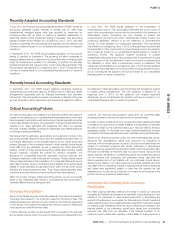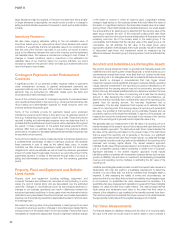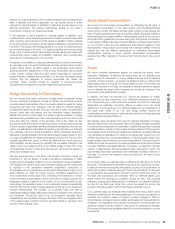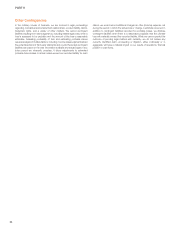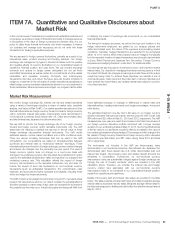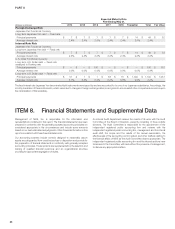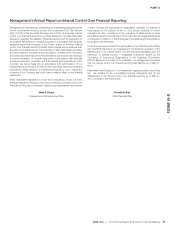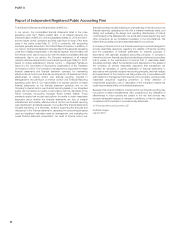Nike 2013 Annual Report Download - page 33
Download and view the complete annual report
Please find page 33 of the 2013 Nike annual report below. You can navigate through the pages in the report by either clicking on the pages listed below, or by using the keyword search tool below to find specific information within the annual report.PART II
Transactional exposures
We conduct business in various currencies and have transactions which
subject us to foreign currency risk. Our most significant transactional foreign
currency exposures are:
• Product Costs — NIKE’s product costs are exposed to fluctuations in
foreign currencies in the following ways:
1. Product purchases denominated in currencies other than the
functional currency of the transacting entity:
a. Certain NIKE entities purchase product from the NTC, a wholly-
owned sourcing hub that buys NIKE branded products from third
party factories, predominantly in U.S. Dollars. The NTC, whose
functional currency is the U.S. Dollar, then sells the products to
NIKE entities in their respective functional currencies. When the
NTC sells to a NIKE entity with a different functional currency, the
result is a foreign currency exposure for the NTC.
b. Other NIKE entities purchase product directly from third-party
factories in U.S. Dollars. These purchases generate a foreign
currency exposure for those NIKE entities with a functional
currency other than the U.S. Dollar.
In both purchasing scenarios, a weaker U.S. Dollar reduces the
inventory cost incurred by NIKE whereas a stronger U.S. Dollar
increases its cost.
2. Factory input costs: In January 2012, NIKE implemented a foreign
currency adjustment program with certain factories. The program is
designed to more effectively manage foreign currency risk by
assuming certain of the factories’ foreign currency exposures, some
of which are natural offsets to our existing foreign currency exposures.
Under this program, our payments to these factories are adjusted for
rate fluctuations in the basket of currencies (“factory currency
exposure index”) in which the labor, materials and overhead costs
incurred by the factories in the production of NIKE branded products
(“factory input costs”) are denominated.
For the currency within the factory currency exposure indices that is
the local or functional currency of the factory, the currency rate
fluctuation affecting the product cost is recorded within inventories
and is recognized in cost of sales when the related product is sold to a
third-party. All currencies within the indices, excluding the U.S. Dollar
and the local or functional currency of the factory, are recognized as
embedded derivative contracts and are recorded at fair value through
other (income) expense, net. Refer to Note 17 — Risk Management
and Derivatives for additional detail.
As an offset to the impacts of the fluctuating U.S. Dollar on our non-
functional currency denominated product purchases described
above, a strengthening U.S. Dollar against the foreign currencies
within the factory currency exposure indices decreases NIKE’s
U.S. Dollar inventory cost. Conversely, a weakening U.S. Dollar
against the indexed foreign currencies increases our inventory cost.
• Non-Functional Currency Denominated External Sales — A portion of our
Western Europe and Central & Eastern Europe geography revenues are
earned in currencies other than the Euro (e.g. British Pound) but are
recognized at a subsidiary that uses the Euro as its functional currency.
These sales generate a foreign currency exposure.
• Other Costs — Non-functional currency denominated costs, such as
endorsement contracts, intercompany royalties and other intercompany
charges, also generate foreign currency risk though to a lesser extent.
• Non-Functional Currency Denominated Monetary Assets and Liabilities —
Our global subsidiaries have various assets and liabilities, primarily
receivables and payables, denominated in currencies other than their
functional currencies. These balance sheet items are subject to re-
measurement, which may create fluctuations in other (income) expense, net
within our consolidated results of operations.
Managing transactional exposures
Transactional exposures are managed on a portfolio basis within our foreign
currency risk management program. We manage these exposures by taking
advantage of natural offsets and currency correlations that exist within the
portfolio and may also elect to use currency forward and option contracts to
hedge the remaining effect of exchange rate fluctuations on probable
forecasted future cash flows, including certain product cost exposures, non-
functional currency denominated external sales and other costs described
above. Generally, these are accounted for as cash flow hedges in accordance
with the accounting standards for derivatives and hedging, except for hedges
of the embedded derivatives component of the product cost exposures as
discussed below.
Certain currency forward contracts used to manage the foreign exchange
exposure of non-functional currency denominated monetary assets and
liabilities subject to re-measurement and the embedded derivative contracts
discussed above are not formally designated as hedging instruments under
the accounting standards for derivatives and hedging. Accordingly, changes
in fair value of these instruments are immediately recognized in other (income)
expense, net and are intended to offset the foreign currency impact of the re-
measurement of the related non-functional currency denominated asset or
liability or the embedded derivative contract being hedged.
Refer to Note 6 — Fair Value Measurements and Note 17 — Risk
Management and Derivatives in the accompanying Notes to the Consolidated
Financial Statements for additional description of how the above financial
instruments are valued and recorded as well as the fair value of outstanding
derivatives at period end.
Translational exposures
Many of our foreign subsidiaries operate in functional currencies other than
the U.S. Dollar. Fluctuations in currency exchange rates create volatility in our
reported results as we are required to translate the balance sheets,
operational results and cash flows of these subsidiaries into U.S. Dollars for
consolidated reporting. The translation of foreign subsidiaries’ non-U.S. Dollar
denominated balance sheets into U.S. Dollars for consolidated reporting
results in a cumulative translation adjustment to OCI within shareholders’
equity. In the translation of our consolidated statements of income, a weaker
U.S. Dollar in relation to foreign functional currencies benefits our consolidated
earnings whereas a stronger U.S. Dollar reduces our consolidated earnings.
The impact of foreign exchange rate fluctuations on the translation of our
consolidated revenues was a benefit (detriment) of approximately $(605)
million and $268 million for the years ended May 31, 2013 and 2012,
respectively. The impact of foreign exchange rate fluctuations on the
translation of our income before income taxes was a benefit (detriment) of
approximately $(104) million and $74 million for the years ended May 31,
2013 and 2012, respectively.
Managing translational exposures
To minimize the impact of translating foreign currency denominated revenues
and expenses into U.S. Dollars for consolidated reporting, certain foreign
subsidiaries use excess cash to purchase U.S. Dollar denominated available-
for-sale investments. The variable future cash flows associated with the
purchase and subsequent sale of these U.S. Dollar denominated securities at
non-U.S. Dollar functional currency subsidiaries creates a foreign currency
exposure that qualifies for hedge accounting under the accounting standards
for derivatives and hedging. We utilize forward contracts and/or options to
mitigate the variability of the forecasted future purchases and sales of these
U.S. Dollar investments. The combination of the purchase and sale of the
U.S. Dollar investment and the hedging instrument has the effect of partially
offsetting the year-over-year foreign currency translation impact on net
earnings in the period the investments are sold. Hedges of available-for- sale
investments are accounted for as cash flow hedges.
78


